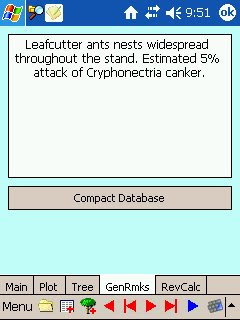One of the most labor and time-consuming processes in forestry are the field data gathering-related processes involved in forest mensuration. When performing field work, foresters usually record their data on a field notebook, or in some cases on specialized field sheets or tally books. The time required for painstakingly hand-typing dozens or even hundreds of field sheets worth of data before they can be processed also takes up valuable time that should be instead spent in analyses. Furthermore, even more mundane problems can arise, such as bad handwriting and actual errors found in field sheets or notebooks because of the mistakes that can occur in any one or more of the several stages the data undergoes.
 That sort of errors can only be corrected by going back to the field, something that is not always possible if the data has to be processed far away from it, as it is often the case when performing biometric sampling or any other kind of forest mensuration activities in the tropics, and even in some cases the measured object may not be available again because of other factors, such as when destructive sampling had to be performed, or when public order provides a narrow window of opportunity for visiting some sites (i.e., you can only go to the area for a short period of time when there is no fighting).
That sort of errors can only be corrected by going back to the field, something that is not always possible if the data has to be processed far away from it, as it is often the case when performing biometric sampling or any other kind of forest mensuration activities in the tropics, and even in some cases the measured object may not be available again because of other factors, such as when destructive sampling had to be performed, or when public order provides a narrow window of opportunity for visiting some sites (i.e., you can only go to the area for a short period of time when there is no fighting).
Ideally, measurements taken in the field, for instance, tree height and diameter data of a permanent or temporal plot should be not only safeguarded against most of the aforementioned error causes, but should also be updated in real time back in the office, in the global database available for the stand, in case something happens to the data on the way back to the lab and the data are damaged (for instance, by rain) or lost (capsizing of a canoe, theft).
Until only a few years ago, there were little alternatives to semi-automated field data collecting in forestry. Some foresters chose to write data on scientific calculators or cumbersome data loggers, but data input and checking was difficult as data volume increased, as was the uncertainty of retrieving the data, something which depended in many cases on the device’s battery life, because data was not conserved if the device ran out of energy. Besides, those early devices were heavy and cumbersome to carry, with difficult to read screens in field conditions, and they were often quite expensive and went rapidly obsolete due to their proprietary interfaces and cable connectors, lacking an industry standard to rely upon.
That started to change with the advent of handheld computers in the form of Palm and Pocket PC handheld devices, all of which started coming into the mainstream market in 1999. Handheld computers intend to deliver to the end user data processing functionality similar to that of tablet, laptop and desktop computers at a fraction of the size, if not always the price. Of course, some compromises had to be made, being the most obvious screen size and the storage/processing capacity and speed of the devices. Also, programs that run on a normal computer will not work directly in typical handheld devices, and vice versa. They employ a reduced (and modified) subset of the original sized computer’s operating system, but the processor is somewhat different, so they need software written specifically for the devices, and some proprietary aspects remain, being the devices themselves however highly standardized for their communication and data transfer with “normal” computers.
Within the market of handheld computers, devices of the Palm system are slightly more widespread among the usual consumer. However, among corporate users, Pocket PCs are by far the most used. But for some industrial uses (such as forestry field work), common Pocket PCs are not rugged or strong enough to withstand the conditions as they come out of the box, i.e., they are not designed for being dropped to hard surfaces, being on moist or dusty environments, being sprayed upon or submerged in water, or run for many hours on a single battery charge, away from electrical outlets. That is why there exists what is called the vertical market, which consists of rugged devices designed for being (reasonably) roughly handled, and special cases to make even consumer-grade handheld devices more resistant to outdoors conditions are also available. We have reached a stage in which automated field data collecting is not only feasible but truly affordable and desirable.
In this blog we discuss the development of a field data capture system designed for forest inventory operations, aiming to trap most of the errors the users could incur into, minimizing also the stages of the data gathering process, therefore making it less complex and therefore less prone to error. A simpler version of the system has been tested in the field since 2003 in Colombia by Silvano Ltd, a forestry consultation company specialized in forest mensuration and is now being integrated and expanded to include navigation and mapping capabilities. We intend to receive feedback from prospective users.





.bmp)
.bmp)
